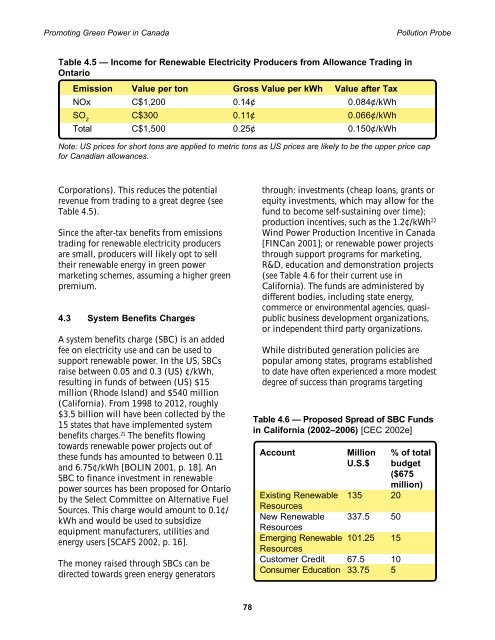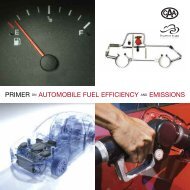Promoting Green Power in Canada - Centre for Human Settlements
Promoting Green Power in Canada - Centre for Human Settlements
Promoting Green Power in Canada - Centre for Human Settlements
- No tags were found...
You also want an ePaper? Increase the reach of your titles
YUMPU automatically turns print PDFs into web optimized ePapers that Google loves.
<strong>Promot<strong>in</strong>g</strong> <strong>Green</strong> <strong>Power</strong> <strong>in</strong> <strong>Canada</strong> Pollution ProbeTable 4.5 — Income <strong>for</strong> Renewable Electricity Producers from Allowance Trad<strong>in</strong>g <strong>in</strong>OntarioEmission Value per ton Gross Value per kWh Value after TaxNOx C$1,200 0.14¢ 0.084¢/kWhSO 2C$300 0.11¢ 0.066¢/kWhTotal C$1,500 0.25¢ 0.150¢/kWhNote: US prices <strong>for</strong> short tons are applied to metric tons as US prices are likely to be the upper price cap<strong>for</strong> Canadian allowances.Corporations). This reduces the potentialrevenue from trad<strong>in</strong>g to a great degree (seeTable 4.5).S<strong>in</strong>ce the after-tax benefits from emissionstrad<strong>in</strong>g <strong>for</strong> renewable electricity producersare small, producers will likely opt to selltheir renewable energy <strong>in</strong> green powermarket<strong>in</strong>g schemes, assum<strong>in</strong>g a higher greenpremium.4.3 System Benefits ChargesA system benefits charge (SBC) is an addedfee on electricity use and can be used tosupport renewable power. In the US, SBCsraise between 0.05 and 0.3 (US) ¢/kWh,result<strong>in</strong>g <strong>in</strong> funds of between (US) $15million (Rhode Island) and $540 million(Cali<strong>for</strong>nia). From 1998 to 2012, roughly$3.5 billion will have been collected by the15 states that have implemented systembenefits charges. 21 The benefits flow<strong>in</strong>gtowards renewable power projects out ofthese funds has amounted to between 0.11and 6.75¢/kWh [BOLIN 2001, p. 18]. AnSBC to f<strong>in</strong>ance <strong>in</strong>vestment <strong>in</strong> renewablepower sources has been proposed <strong>for</strong> Ontarioby the Select Committee on Alternative FuelSources. This charge would amount to 0.1¢/kWh and would be used to subsidizeequipment manufacturers, utilities andenergy users [SCAFS 2002, p. 16].The money raised through SBCs can bedirected towards green energy generatorsthrough: <strong>in</strong>vestments (cheap loans, grants orequity <strong>in</strong>vestments, which may allow <strong>for</strong> thefund to become self-susta<strong>in</strong><strong>in</strong>g over time);production <strong>in</strong>centives, such as the 1.2¢/kWh 22W<strong>in</strong>d <strong>Power</strong> Production Incentive <strong>in</strong> <strong>Canada</strong>[FINCan 2001]; or renewable power projectsthrough support programs <strong>for</strong> market<strong>in</strong>g,R&D, education and demonstration projects(see Table 4.6 <strong>for</strong> their current use <strong>in</strong>Cali<strong>for</strong>nia). The funds are adm<strong>in</strong>istered bydifferent bodies, <strong>in</strong>clud<strong>in</strong>g state energy,commerce or environmental agencies, quasipublicbus<strong>in</strong>ess development organizations,or <strong>in</strong>dependent third party organizations.While distributed generation policies arepopular among states, programs establishedto date have often experienced a more modestdegree of success than programs target<strong>in</strong>gTable 4.6 — Proposed Spread of SBC Funds<strong>in</strong> Cali<strong>for</strong>nia (2002–2006) [CEC 2002e]Account Million % of totalU.S.$ budget($675million)Exist<strong>in</strong>g Renewable 135 20ResourcesNew Renewable 337.5 50ResourcesEmerg<strong>in</strong>g Renewable 101.25 15ResourcesCustomer Credit 67.5 10Consumer Education 33.75 578
















